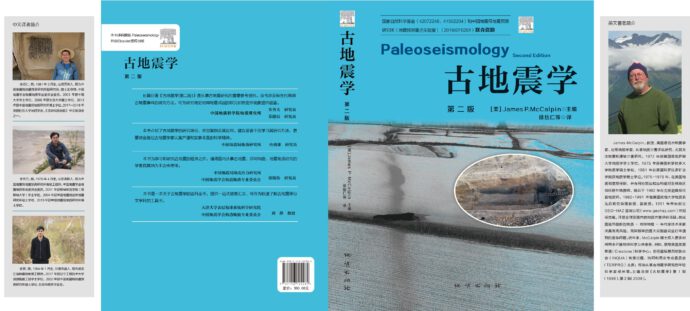Better late than never – here are the latest papers! Enjoy reading and let me know if I have missed anything.
morePosts in the category » Paper « ( 280 Posts )
-
New papers on paleoseismology, earthquakes, and active tectonics (June 2021)
-
New papers on paleoseismology, earthquakes, and active tectonics (May 2021)
-
New papers on paleoseismology, earthquakes, and active tectonics (Apr 2021)
2021-04-01 | in PaperJust as last month we have a veeeery long list today. Quite a number of papers deal with new data from Central Asia and S America, but of course there’s also something on the menu for connoisseurs of archaeoseismology, European, N American & African tectonics, and physics-based fault studies. Enjoy reading, stay safe and let me know if I’ve overlooked something.
more -
Call for papers: Special Issue on the 2021 Northern Thessaly, Greece, earthquake sequence
2021-03-22 | in Earthquake, PaperThe Bulletin of the Geological Society of Greece (BGSG) is inviting papers for a Special Issue on the 2021 Northern Thessaly, Greece, Earthquake Sequence. This sequence included a M6.3 mainshock on March 3, followed 32 hours later by a M6.0 event and a M5.6 event on March 12, and thousands of smaller aftershocks. This was the most significant earthquake sequence in northern Thessaly in 80 years, and the first large events in this area of Greece since the major upgrades of the seismological, strong motion and geodetic networks. Remote-sensing imagery is available from a number of satellites and other platforms. The sequence raises numerous questions related to fault interactions, blind faulting, near- and far-field ground motions, damage distribution, earthquake triggering, liquefaction phenomena and seismic hazard and seismotectonics of the Northern Thessaly.
more -
Link tectonic processes to the seismic cycle: A 2-Myr-long seismite record from NE Tibet
2021-03-10 | in PaperA recent study investigated disturbances that preserved in the upper 260 m of a 723-m deep core drilled on the crest of a thrust-cored anticline in the western Qaidam Basin, NE Tibet.
1. Key Points:
more
• We interpret micro-faults, soft-sediment deformation, slumps, and detachment surfaces as paleoearthquake/tectonic indicators
• The core records five seismite clusters between 3.6 and 2.7 Ma, revealing episodic thrusting in relation to intense regional deformation
• During the clusters, regional deformation was concentrated more in the fold-and-thrust system than along regional major strike-slip faults -
New papers on paleoseismology, earthquakes, and active tectonics (Mar 2021)
2021-03-02 | in PaperToday’s list is again very long. It contains a lot of really cool stuff from Central Europe and the Alps, and many interesting studies from China and Central Asia. Connoisseurs of American tectonics will also be happy I promise. Plus, quite a number of papers on methods and earthquake/fault physics in general. Enjoy reading!
more -
Features of seismogenic turbidites from the Dead Sea depocenter
2021-02-09 | in PaperA recent study investigated turbidites that preserved in a 457-m deep ICDP drilling from the Dead Sea depocenter. This is the first work to show detailed information on turbidites in the region.
1. Key Points:
- Seismic origin for prehistoric turbidites is established by analyzing the underlying in situ deformation structures for each turbidite
- Data validate a previous hypothesis that soft-sediment deformation formed at the sediment-water interface in the Dead Sea
- The new approach permits a more confident geohazard assessment by improving the completeness of a paleoseismic archive
-
New papers on paleoseismology, earthquakes, and active tectonics (Feb 2021)
2021-02-02 | in PaperThis time we have a lot of papers on the active tectonics of the Americas, especially along their west coast. Of course on the west coast you say? Sure, but the recent M5.6 in Guyana, a shallow thrust event in a seemingly aseismic area, reminded us that such quakes can basically happen everywhere and at any time – they are just rare and hard to find in the geological record. Enjoy reading!
more -
28–17 Ma old uplifted marine terraces in the Dinarides
2021-01-29 | in PaperIn 2018, back then when we didn’t even knew about Covid-19, I was sitting in a little restaurant in Slovenia with my happy field team. We were exhausted from another long day of geophysical surveys for our active tectonics project and quite thirsty. A colleague of mine, Philipp Balling, had just finished his field work in Croatia and was on his way north to join us for a few days before he would continue to Jena. He arrived late that evening and we had a great time catching up with each others stories from the field. He showed me a few photos, one of them displaying a huge, flat area at the Croatian coast. I was immediately alerted and asked if the Croatian coast was uplifting, because this thing looked like a marine abrasion platform to me. We chatted about uplifted marine terraces until long after midnight, and this is how the story of this paper began.
more -
古地震学: “Paleoseismology” by Jim McCalpin now available in Chinese
2021-01-12 | in paleoseismicity.org, PaperJim McCalpin’s famous “Paleoseismology” is now also available in Chinese. The book was translated by Xu Yueren, Li Wenqiao, and Du Peng.
- Price: 300 Yuan
- ISBN: 978-7-116-12228-4
- Printed in Beijing, October 2020
- Details and where to buy it: https://www.mine999.cn/news/show-415182811.html

By the way, “Палеосейсмология” is also available in Russian: https://www.livelib.ru/book/1001089368-paleosejsmologiya-komplekt-iz-2-knig-cd
